
K-141 Kursk was an Oscar II-class nuclear-powered cruise missile submarine of the Russian Navy. On 12 August 2000, K-141 Kursk was lost when it sank in the Barents Sea, killing all 118 personnel on board.

The Finnish Navy is one of the branches of the Finnish Defence Forces. The navy employs 2,300 people and about 4,300 conscripts are trained each year. Finnish Navy vessels are given the ship prefix "FNS", short for "Finnish Navy ship", but this is not used in Finnish language contexts. The Finnish Navy also includes coastal forces and coastal artillery.
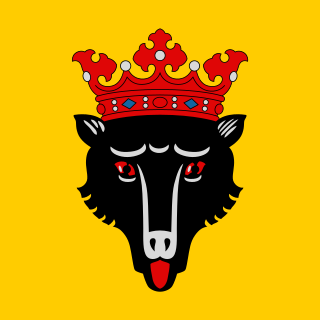
Pori is a city and municipality on the west coast of Finland. The city is located some 10 kilometres (6 mi) from the Gulf of Bothnia, on the estuary of the Kokemäki River, 110 kilometres (68 mi) west of Tampere, 140 kilometres (87 mi) north of Turku and 241 kilometres (150 mi) north-west of Helsinki, the capital of Finland. Pori was established in 1558 by Duke John, who later became King John III of Sweden.

Ilmarinen was a Finnish Navy Panssarilaiva, Swedish Pansarskepp. The unit was constructed at the Crichton-Vulcan shipyard in Turku, Finland, and named after the mythological hero Ilmarinen from the Finnish national epic, the Kalevala. Ilmarinen was the flagship of the Navy from 1 May 1933 until her sinking on 13 September 1941.

The nuclear-powered Project 949A Antey submarine K-141 Kursk sank in an accident on 12 August 2000 in the Barents Sea. It was taking part in the first major Russian naval exercise in more than 10 years. All 118 personnel on board were killed. The crews of nearby ships felt an initial explosion and a second, much larger explosion, but the Russian Navy did not realise that an accident had occurred and did not initiate a search for the vessel for over six hours. The submarine's emergency rescue buoy had been intentionally disabled during an earlier mission and it took more than 16 hours to locate the submarine, which rested on the ocean floor at a depth of 108 m.

The Baltic Sea Campaigns were conducted by Axis and Allied naval forces in the Baltic Sea, its coastal regions, and the Gulf of Finland on the Eastern Front of World War II. After early fighting between Polish and German forces, the main combatants were the Kriegsmarine and the Soviet Navy, with Finland supporting the Germans until 1944 and the Soviets thereafter. The Swedish Navy and merchant fleet played important roles, and the British Royal Navy planned Operation Catherine for control of the Baltic Sea and its exit choke point into the North Sea.

Turunmaa was a Finnish gunboat built in 1918. She served in the Finnish Navy during World War II. The ship was named after Turuma, a type of frigate designed for use in shallow waters of the archipelago and served in the Swedish Archipelago fleet in the late 18th century. The frigates had in turn been named after the region of Finland.

Karjala (ex-Filin) was a Finnish gunboat, built in 1918 at Ab Crichton shipyard in Turku. She served in the Finnish Navy during World War II. Karjala was named after the Finnic cultural region of Karelia. Like her sister ship Turunmaa, she served as cadet training vessel during peacetime and was nicknamed as Kurjala by cadets.
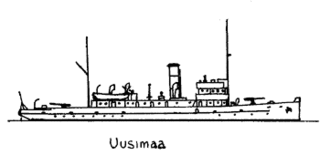
Uusimaa was a gunboat that served in the Finnish Navy during World War II. She was built in 1917. As the ship had changed hands many times during the turbulent last years of World War I she had been renamed many times: In Russian service, she was called Golub, later, in German service, her name was Beo. Finally the Germans handed her over to the Finns in 1920, who renamed her Uusimaa. After World War II, she served as a trawler in the Baltic Sea. She was scrapped in 1953.

Hämeenmaa was a gunboat that served in the Finnish Navy during World War II. She was built in 1917. As the ship had changed hands many times during the turbulent last years of World War I she had been renamed many times: In Russian service, she was called Pingvin; later, in German service, her name was Wulf. Finally, in 1920, the Germans handed her over to the Finns, who renamed her Hämeenmaa. After World War II, she served as a trawler in the Baltic Sea. She was scrapped in 1953.
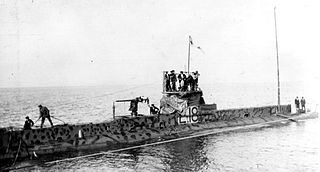
A British submarine flotilla operated in the Baltic Sea for three years during the First World War. The squadron of nine submarines was attached to the Russian Baltic Fleet. The main task of the flotilla was to prevent the import of iron ore from Sweden to Imperial Germany. The success of the flotilla also forced the German Navy in the Baltic to keep to their bases and denied the German High Seas Fleet a training ground. The flotilla was based in Reval (Tallinn), and for most of its career commanded by Captain Francis Cromie.

The Finnish S-class torpedo boats was a series of six ex-Russian torpedo boats that had been taken over by the Finns after the Russian Revolution and the Finnish Civil War.

T3 was a sea-going torpedo boat that was operated by the Royal Yugoslav Navy between 1921 and 1941. Originally 78 T, a 250t-class torpedo boat of the Austro-Hungarian Navy built in 1914, she was armed with two 66 mm (2.6 in) guns, four 450 mm (17.7 in) torpedo tubes, and could carry 10–12 naval mines. She saw active service during World War I, performing convoy, escort and minesweeping tasks, anti-submarine operations and shore bombardment missions. In 1917 the suffixes of all Austro-Hungarian torpedo boats were removed, and thereafter she was referred to as 78. Following Austria-Hungary's defeat in 1918, she was allocated to the Navy of the Kingdom of Serbs, Croats and Slovenes, which subsequently became the Royal Yugoslav Navy, and was renamed T3. At the time, she and the seven other 250t-class boats were the only modern sea-going vessels of the fledgling maritime force.

Reposaari is an island and village at the Bothnian Sea in Pori, Finland.
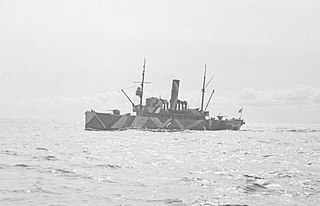
Louhi was a Finnish Navy minelayer. The ship was originally constructed for the Imperial Russian Navy but was taken over by the Finns during the Russian Civil War. She had originally been named Voin, but was renamed as M1 in Finnish service. In 1936 she was given the more personal name Louhi, following the procedure of all other major ships in the Finnish navy.
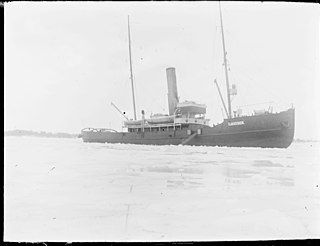
Silatch was a small Imperial Russian and later Soviet steam-powered icebreaker. She was captured by Finland in the aftermath of the Finnish Civil War in 1918 and renamed Ilmarinen until returned to the Soviet Union in 1922. She was decommissioned in the 1950s.
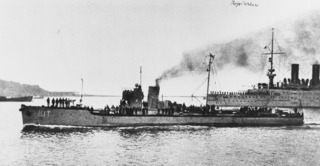
T1 was a seagoing torpedo boat that was operated by the Royal Yugoslav Navy between 1921 and 1941. Originally 76 T, a 250t-class torpedo boat of the Austro-Hungarian Navy built in 1914, she was armed with two 66 mm (2.6 in) guns and four 450 mm (17.7 in) torpedo tubes, and could carry 10–12 naval mines. She saw active service during World War I, performing convoy, escort and minesweeping tasks, anti-submarine operations and shore bombardment missions. In 1917 the suffixes of all Austro-Hungarian torpedo boats were removed, and thereafter she was referred to as 76. She was part of the escort force for the Austro-Hungarian dreadnought Szent István during the action that resulted in the sinking of that ship by Italian torpedo boats in June 1918. Following Austria-Hungary's defeat later that year, she was allocated to the Navy of the Kingdom of Serbs, Croats and Slovenes, which became the Royal Yugoslav Navy, and was renamed T1. At the time, she and seven other 250t-class boats were the only modern sea-going vessels of the fledgling maritime force.

T2 was a seagoing torpedo boat operated by the Royal Yugoslav Navy between 1921 and 1939. Originally 77 T, a 250t-class torpedo boat of the Austro-Hungarian Navy built in 1914, she was armed with two 66 mm (2.6 in) guns, four 450 mm (17.7 in) torpedo tubes, and could carry 10–12 naval mines. She saw active service during World War I, performing convoy, patrol, escort, minesweeping and minelaying tasks, anti-submarine operations, and shore bombardment missions. In 1917 the suffixes of all Austro-Hungarian torpedo boats were removed, and thereafter she was referred to as 77. Following Austria-Hungary's defeat in 1918, she was allocated to the Navy of the Kingdom of Serbs, Croats and Slovenes, which later became the Royal Yugoslav Navy, and was renamed T2. At the time, she and seven other 250t-class boats were the only modern sea-going vessels of the fledgling maritime force.

The Åland War was the operations of a British-French naval force against military and civilian facilities on the coast of the Grand Duchy of Finland in 1854–1856, during the Crimean War between the Russian Empire and the allied France and Britain. The war is named after the Battle of Bomarsund in Åland. Although the name of the war refers to Åland, skirmishes were also fought in other coastal towns of Finland in the Gulf of Bothnia and the Gulf of Finland.

Sokol was the first torpedo boat destroyer built for the Imperial Russian Navy. She was designed and built by the British shipbuilder Yarrows from 1894 to 1895 and was claimed to be the fastest warship in the world during her sea trials. She was renamed Pruitki in 1902.




















